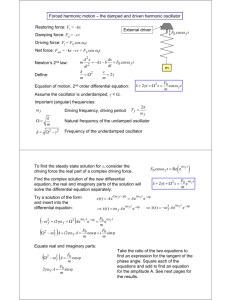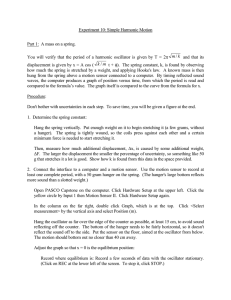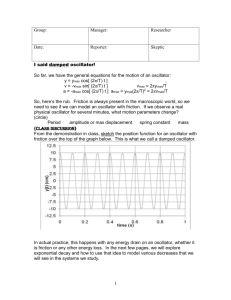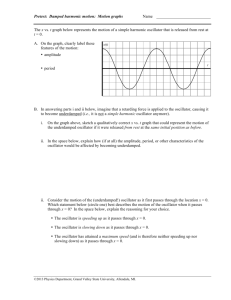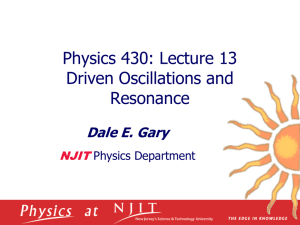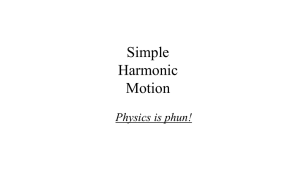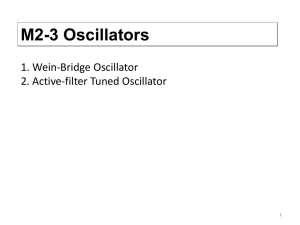Spring and mass oscillator
advertisement
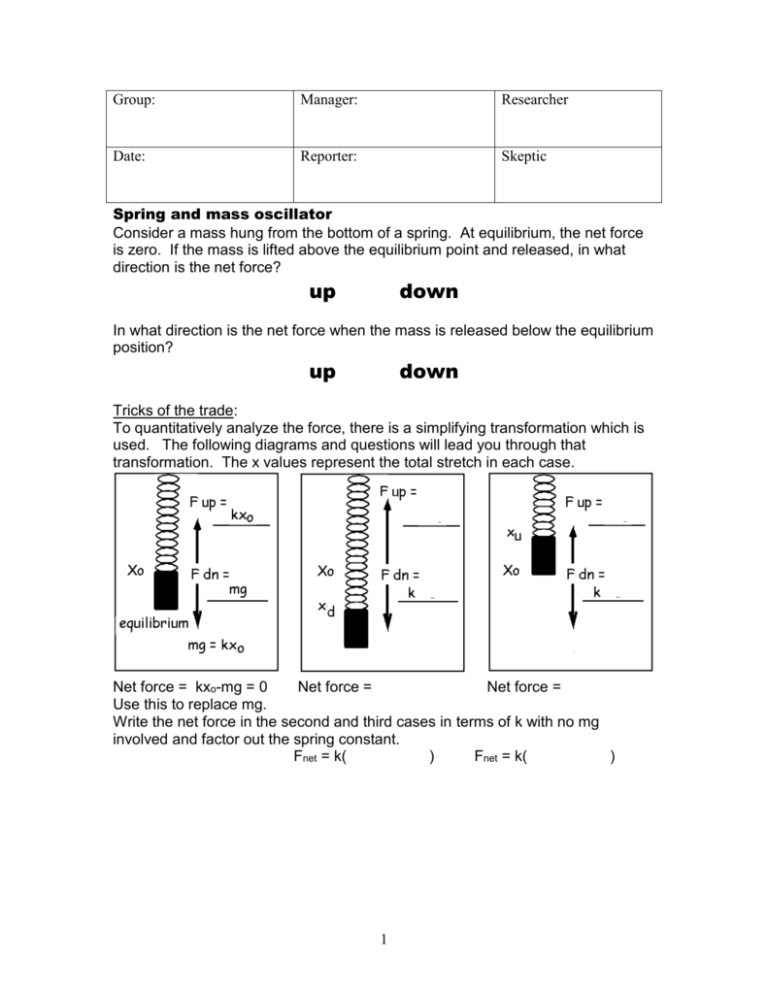
Group: Manager: Researcher Date: Reporter: Skeptic Spring and mass oscillator Consider a mass hung from the bottom of a spring. At equilibrium, the net force is zero. If the mass is lifted above the equilibrium point and released, in what direction is the net force? up down In what direction is the net force when the mass is released below the equilibrium position? up down Tricks of the trade: To quantitatively analyze the force, there is a simplifying transformation which is used. The following diagrams and questions will lead you through that transformation. The x values represent the total stretch in each case. Net force = kxo-mg = 0 Net force = Net force = Use this to replace mg. Write the net force in the second and third cases in terms of k with no mg involved and factor out the spring constant. Fnet = k( ) Fnet = k( ) 1 Now, use the equilibrium position, xo, as the origin for x instead of the unstretched length and use (xd-xo) = yd and (xu-xo) = yu. What do the expressions for the net forces in the second and third cases look like in terms of these new y variables? If we use the downward direction as positive, the two expressions above are particular cases of a force law which can be written as F = -ky Notice the gravity contribution has disappeared! We only need deal with the spring force now. Having a force which is directed opposite to the displacement from equilibrium is the necessary condition for oscillatory motion, otherwise, the object won’t come back! Oscillatory or periodic motion is used to understand such things as the stability of buildings in earthquakes and winds, the infrared spectra of molecules, radio receivers and transmitters and many more systems with stable equilibrium states. To get the rest of the story, we will resort to experiment. For the spring and mass oscillator, what factors affect the period of oscillation? If the position of the mass is plotted versus time, what function describes the curve? Sketch the curve below. 2 Quantitative determination of period: Spring-mass Variables: ______ _______ Pendulum Variables: ______ _______ Position equations From the plot we obtained experimentally, we can see the function is a sinusoidal graph. The simplest form of the equation for the position of the mass in a spring and mass oscillator is y = ymax cos[ (2π/T) t ] = ymax cos[ ω t ] ; ω = √[k/m] For the pendulum, it is θ = θmax cos[ (2π/T) t ] = θmax cos[ ω t ] ; ω = √[g/l] The cosine function was chosen because an oscillator is frequently started by pulling it to a nonequilibrium position and releasing at zero velocity. We can deal with other cases later. To use these forms of motion equation, compare a given equation to the standard form above and identify the values corresponding to the variables. To write an equation, simply put the variables in the correct places. Applications: A pendulum has the equation of motion θ = 20° cos[ 4π t ] . Determine the maximum angle and the length of the pendulm. A spring and mass oscillator has a mass of 0.5 kg and a spring constant of 20 N/m. The mass is lifted 20 cm from equilibrium and released. Write the equation describing the position of the mass versus time. (Calculate the period first.) 3 We also have enough information to write the velocity equation, with a little skull scratching. On the following graph of position versus time, mark the times when the velocity is maximum with an M and the times when it is zero with a 0. What is happening to the motion of the mass at the point where the velocity is zero? (Sound familiar?) What is the function which has its maximum and minimum values where you noted them, relative to the positions? You could lightly connect the M’s and 0’s on the graph, if that helps to see the answer. Since F = -ky and F = ma, what would the acceleration graph look like? Sketch the acceleration graph for the case k/m = 2 If the position function is y = 10 cos(4π t), what would the acceleration function be, given the relations you just worked with? 4 Energy For the spring and mass oscillator (use a horizontal one for this question), what forms of energy are there in the system? What are the expressions for these forms of energy? Are they potential or kinetic? On the following graph of position versus time, mark any points where the energy is all one form or all another; use K for kinetic and P for potential. What is the expression for the total energy of the oscillator at t=0 when it is released at rest? What is the total energy of the oscillator compared to the previous expression? Construct an expression for the maximum velocity of the mass in terms of m, k, ymax and any other quantities you may need. Energy is conserved here (no friction). Another way to think of an oscillator is a system with two forms of energy and a force to transform one form into the other. This is almost always kinetic and potential energy. 5
